Alan Soñora (171cm/5’7”, 65kg/143lbs) is an American-born central midfielder with an increasing influence at Argentinian giants Independiente. Born in New Jersey whilst his father Diego Soñora was playing in the MLS with MetroStars, now known as New York Red Bulls, Alan Soñora is eligible to represent the United States and Argentina. However, Alan is yet to play international football at any level, unlike his brother Joel Soñora, of Vélez Sarsfield, who has represented the USA at under-20 and under-17 levels. Alan has expressed interest in playing for the USMNT, potentially alongside Joel, despite never being called up. With impressive performances continuing, does the Independiente midfielder have a slim chance of entering the fray of Gregg Berhalter’s World Cup midfield selection?
Playing in the academies of Boca Juniors and Independiente, two of Argentina’s Big Five, Soñora made his professional debut for Independiente in September 2019. In his first full season of professional football, Soñora largely struggled for consistent league minutes as he collected 826 minutes in all competitions across 19 matches. 2021 was much better, playing 1,594 minutes in all competitions across 25 matches, as Soñora became a regular starter at Independiente in the second half of the year. These improvements have continued into 2022, with Alan already playing 1,449 minutes from 22 matches, with the bulk of the Primera División fixtures remaining too. Soñora played full nineties in the last four Copa Sudamericana games as Independiente attempted to chase down the flawless group leaders Ceará SC of Brazil.
In this tactical analysis in the form of a scout report, we will take a closer look at Alan Soñora’s playing style at Independiente. We will also assess his suitably for the USMNT with comparisons to other central midfielders in Berhalter’s selection pool as the 2022 World Cup edges closer.
Role at Independiente
One of Soñora’s biggest strengths is his versatility in the midfield, capable of playing deeper or in advanced areas with the ability to utilise angles centrally and out wide for his more dominant left foot. This adaptability has been crucial to his consistent minute-taking in 2022, with Independiente manager Eduardo Domínguez not settling for one formation since his appointment at the start of the year. Their most used formation is a 4-2-3-1 with Soñora usually as the attacking midfielder, but this formation is only used 20% of the time. 18% of Dominguez’s tenure has set the team up in variations of a midfield diamond in a 4-4-2, with a further 15% for variations of a 4-3-3. Independiente have also used a 4-4-2 during 10% of their games in 2022.
In these formations, Soñora typically plays as the attacking midfielder or as a central midfielder. As a result, he has suitably been handed Independiente’s number ‘10’ shirt, formerly of Manchester City legend Sergio ‘Kun’ Agüero, and an iconic number in Argentinian football. However, he has also been deployed deeper in defensive midfield as well as both the left and right-wing. Soñora’s versatility will continue to be used by Independiente, with defensive midfielder Carlos Benavidez, central midfielder Domingo Blanco and attacking midfielder Andrés Roa all departing the club as free agents on the 30th of June.
Considering Soñora is generally deployed as the most advanced midfielder in Dominguez’s system, his attacking output in the final third is fairly unimpressive but overall relatively efficient. With 1.07 touches in the opposition penalty box per 90, it is rare that he will break into the box and move into areas alongside and ahead of the striker. Scoring eight goals in the last 12 months from 4.22 xG, just two of Soñora’s goals have come from inside the box.
Alongside being Independiente’s third top scorer in this period, his 1.89 shots per 90 also rank him 3rd at the club. However, only 26.09% of his shots are on target, ranking him 15th, which is quite baffling for a player of good ball-striking with the ability to execute different techniques.
When watching Soñora operate in the final third with shooting opportunities available, it looks like he can rush his technique to ensure getting a shot off, rather than staying composed. This is strange, considering his brilliant composure in deeper phases, but is not a rarity for players when in the final third. It must be stated that Soñora looks like a player confident in his shooting ability, and rightly so, as shown by his six goals from outside the box.
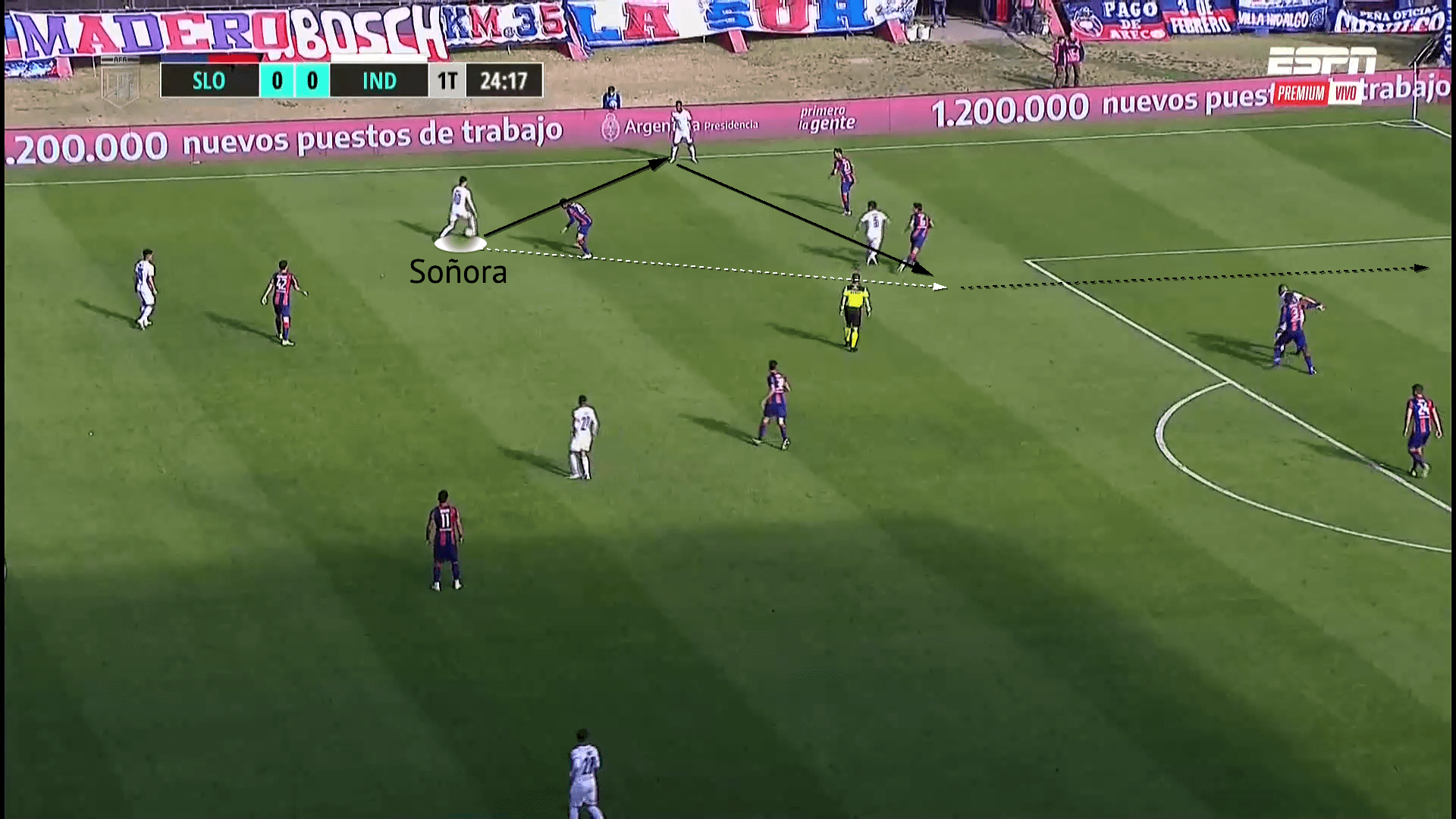
A standout attribute of Soñora is his constant movement to become a passing option, leaving him extremely tough to mark for the opposition. This can be especially influential in the final third to penetrate defensive lines. Alan tends to use these movements to penetrate more than his 1.84 dribbles per 90, despite having a good dribble success rate of 62.69%.
The figures above and below show an example of Soñora combining with Juan Cazares. Immediately after executing the pass, Soñora breaks beyond his marker to receive the return pass before dribbling into the opposition penalty box. Using his impressive ball manipulation, he has left the tracking opponent on the floor and created separation to play a cut-back to the edge of the box. The cut-back was slightly underhit, resulting in the teammate’s shot being promptly blocked.
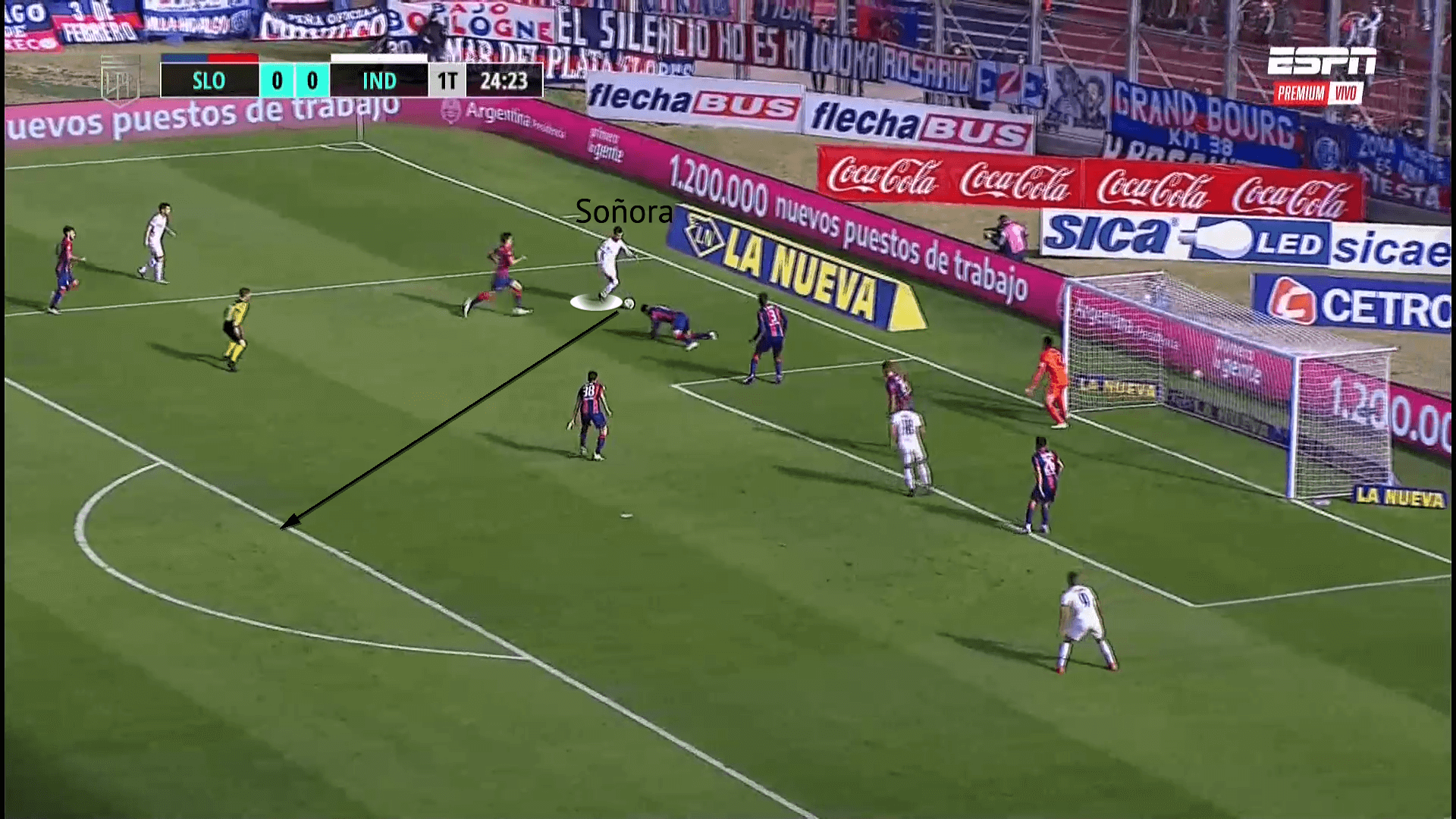
His chance creation from attacking midfield could also be improved, although Independiente’s preference for operating in wide areas does hinder his statistics. Soñora ranks seventh at the club for key passes, with the wide midfielders and full-backs particularly ranking well. His 2.03 passes into the penalty box per 90 ranks him 11th at Independiente, but his accuracy of 59.46% is the best at the club. Alongside his 4.67 xA, which ranks second at Independiente, Soñora should definitely attempt these penetrative passes more frequently. His disguised passes are tough to stop with the timing of his passes and minimal back lift in his technique allowing him to thread passes into teammates with ease.
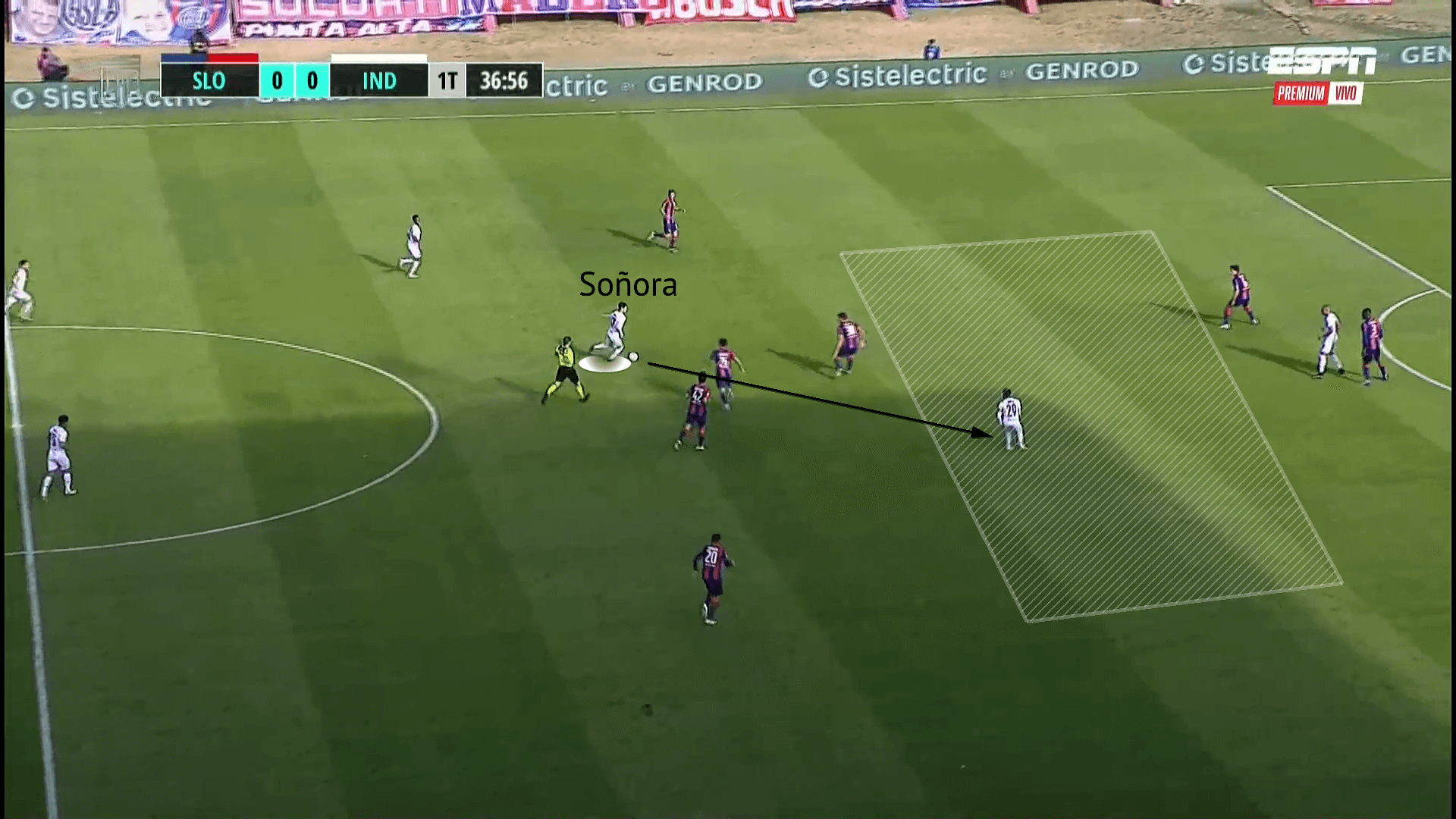
Another strength of Soñora’s game is his ability to draw out opponents and use his technical quality to bypass them. Heavily left-footed, opponents can be deceived by Soñora with the assumption that he will be quite one-dimensional with limited angles from such one-footedness. However, as previously mentioned, his ball manipulation in tight spaces and variety of passing techniques means he can evade opposition pressure. Despite his role as an attacking midfielder, Soñora regularly makes moves into deeper areas. This either drags out opponents or gives him space to turn and play forwards, which is when he is most influential.
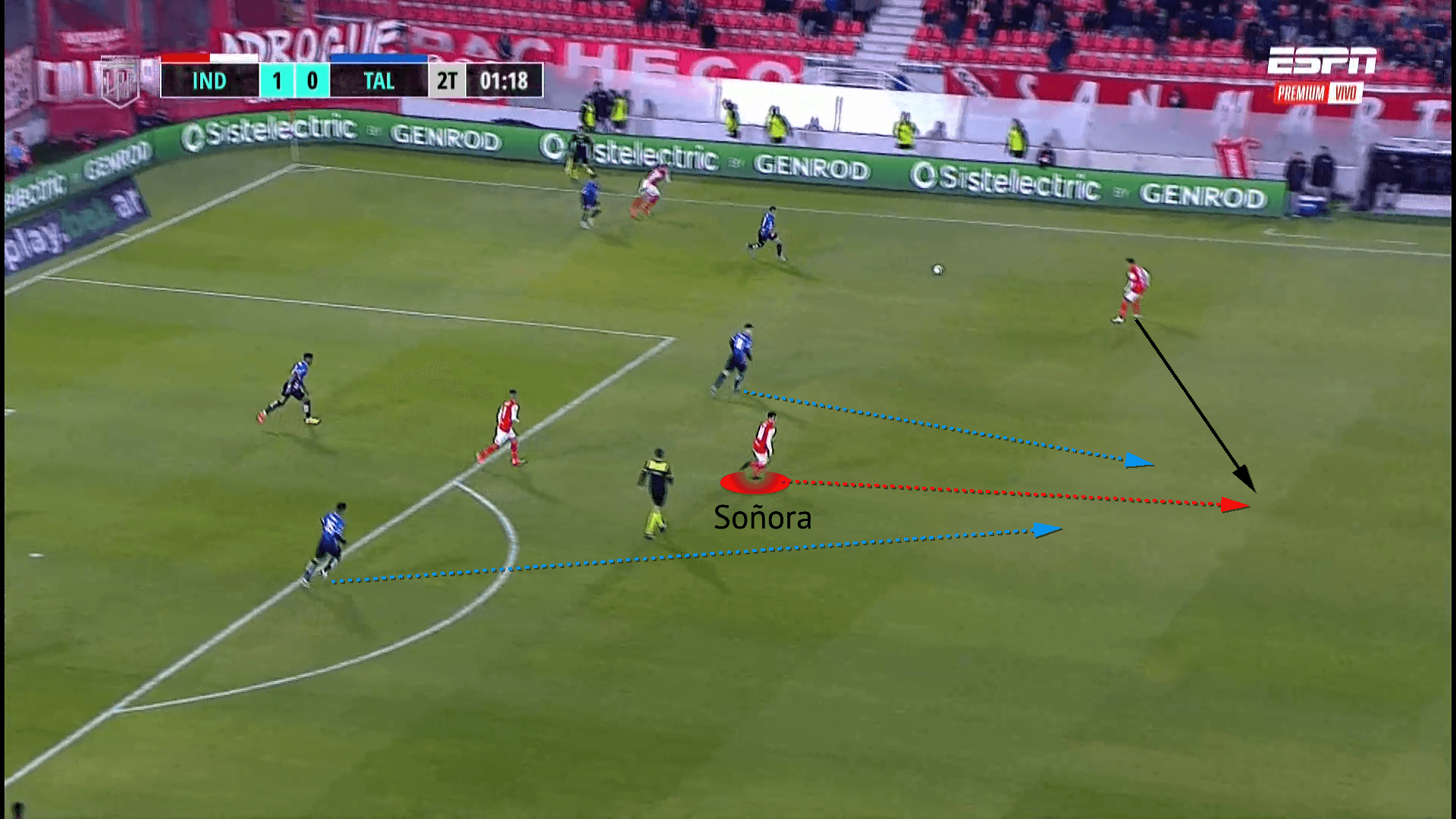
This is an example of Soñora displaying all of his best abilities and habits against Club Atlético Talleres. Soñora vacates the typical attacking midfield space to drop and become a passing option, attracting the attention of two Talleres midfielders. The American uses his aforementioned technical abilities to draw in the two midfielders to decongest the final third and create space in zone 14 and thread a pass into an attacker. Despite options wide and centrally, the attacker returns the pass to Soñora, who has moved to become a passing option and find the right width-holder.
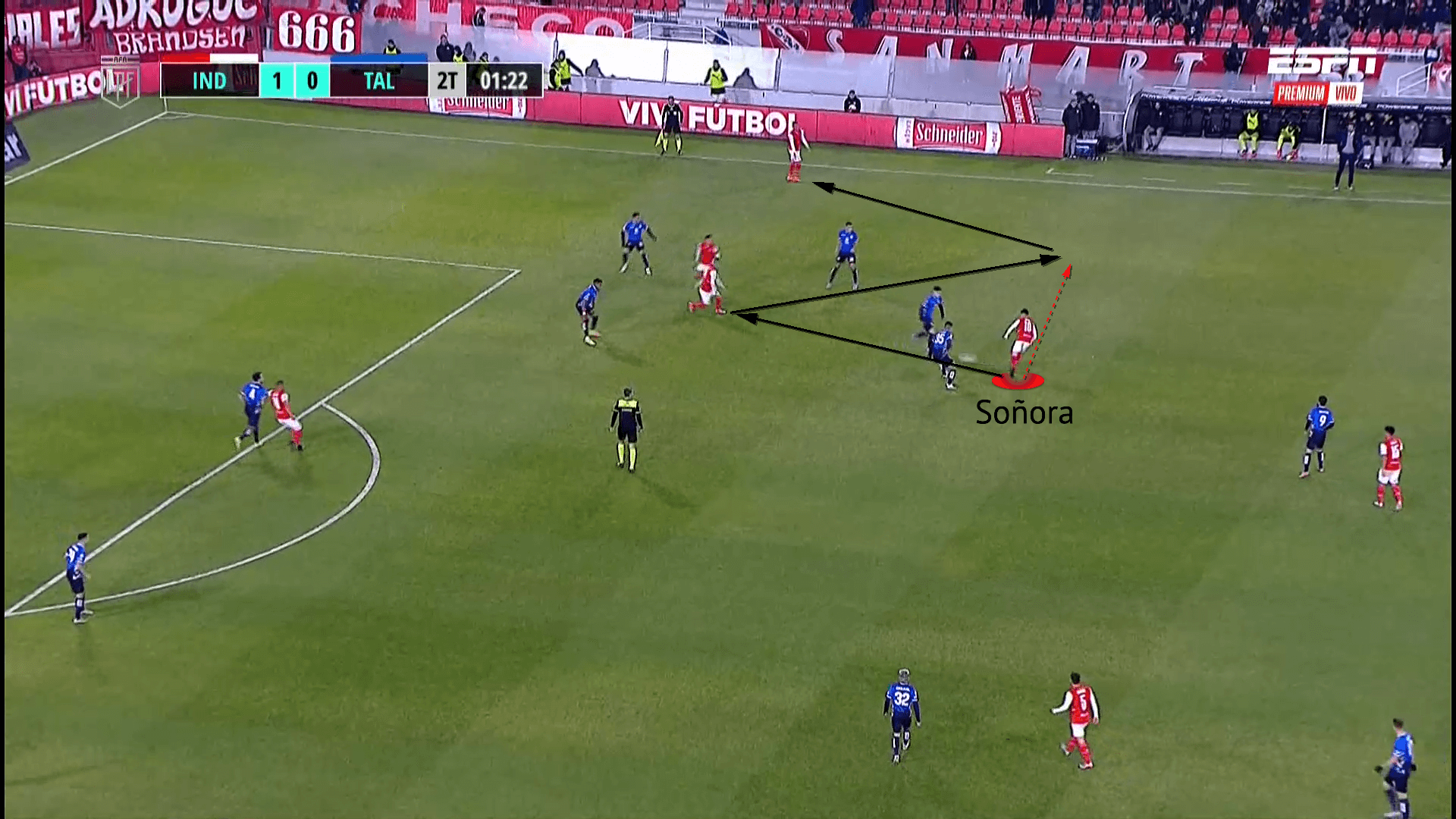
Soñora’s movement is crucial for both ball retention and progression, actively looking to sustain possession and picking up smart positions create overloads. With Independiente’s wide players having a major role in possession, dominating the wide areas can allow the team to gain control. They can do this by overloading the wide areas. In the figure below, Soñora has drifted to the right-wing to create a 4vs3 in the widest channel. Receiving between the lines, he has pulled out the Talleres left-back. The defensive perturbation caused by Soñora’s movement has created space for his teammate up the channel to receive in space and attack the underloaded Talleres defence.
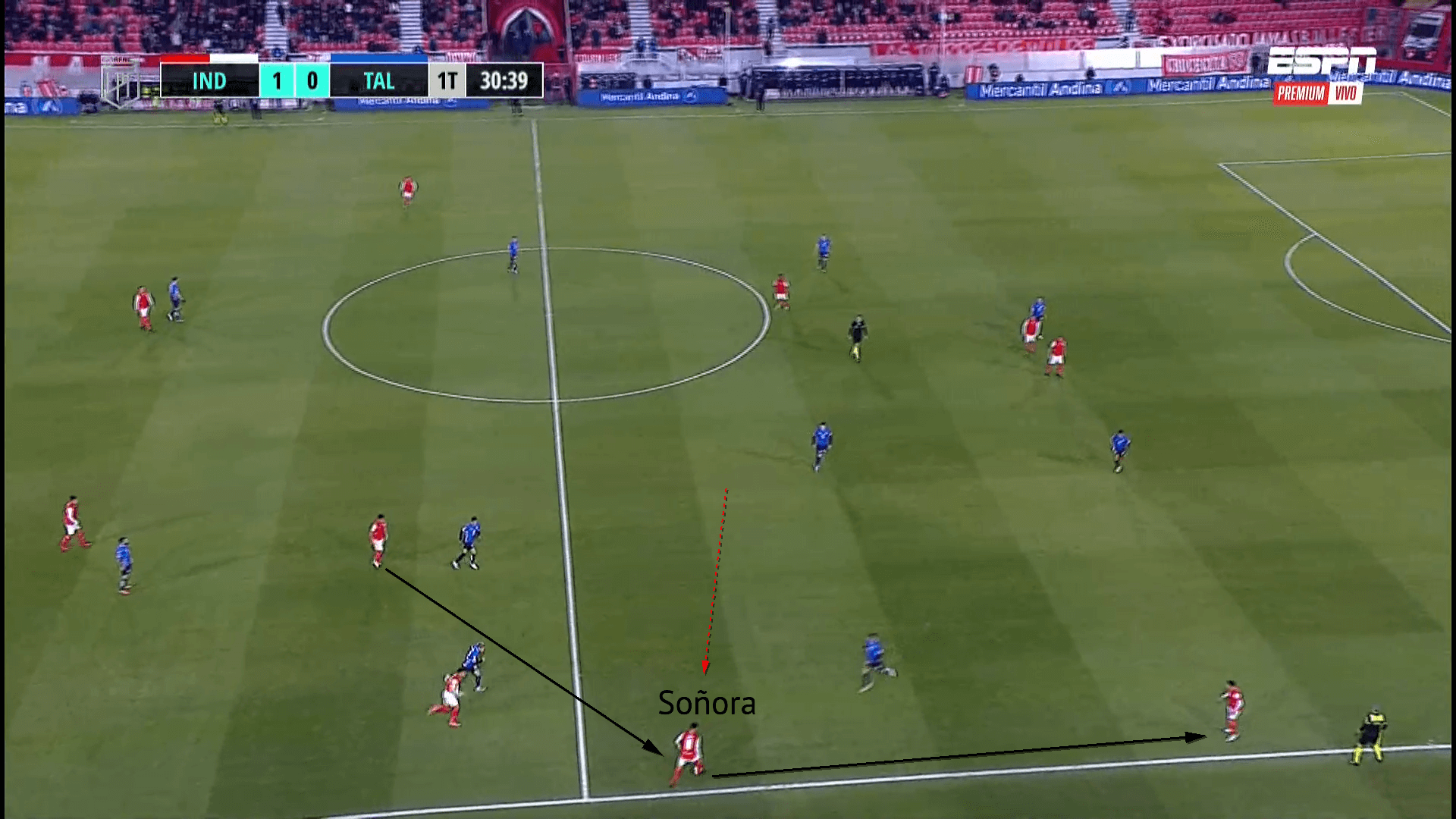
The American also drops deep to assist Independiente in the phases of build-up and consolidation to enter the penetration phase. These areas are where Soñora can utilise his exceptional passing accuracy. However, his role at Independiente is not as the primary progressor of the side, although this does seem like a responsibility he could excel at. He completes 14.79 forward passes per 90, ranking him 9th at the club, but his accuracy of 83.25% is the best at the club. Additionally, his 8.55 passes into the final third ranks him third but his 91.03% accuracy is staggeringly good, suggesting his ability to find teammates from deeper should be used more frequently.
However, Soñora does display some bad habits in the build-up phase that can leave him susceptible to opposition tackles. Receiving with his back to goal in the build-up phase, he regularly only scans over his right shoulder instead of both. This can lead to opponents coming from his blindside to regain possession, which is especially dangerous in Independiente’s defensive third. The figure below is an example of this against Argentinos Juniors, with further examples awaiting in the next section of the scout report and analysis.
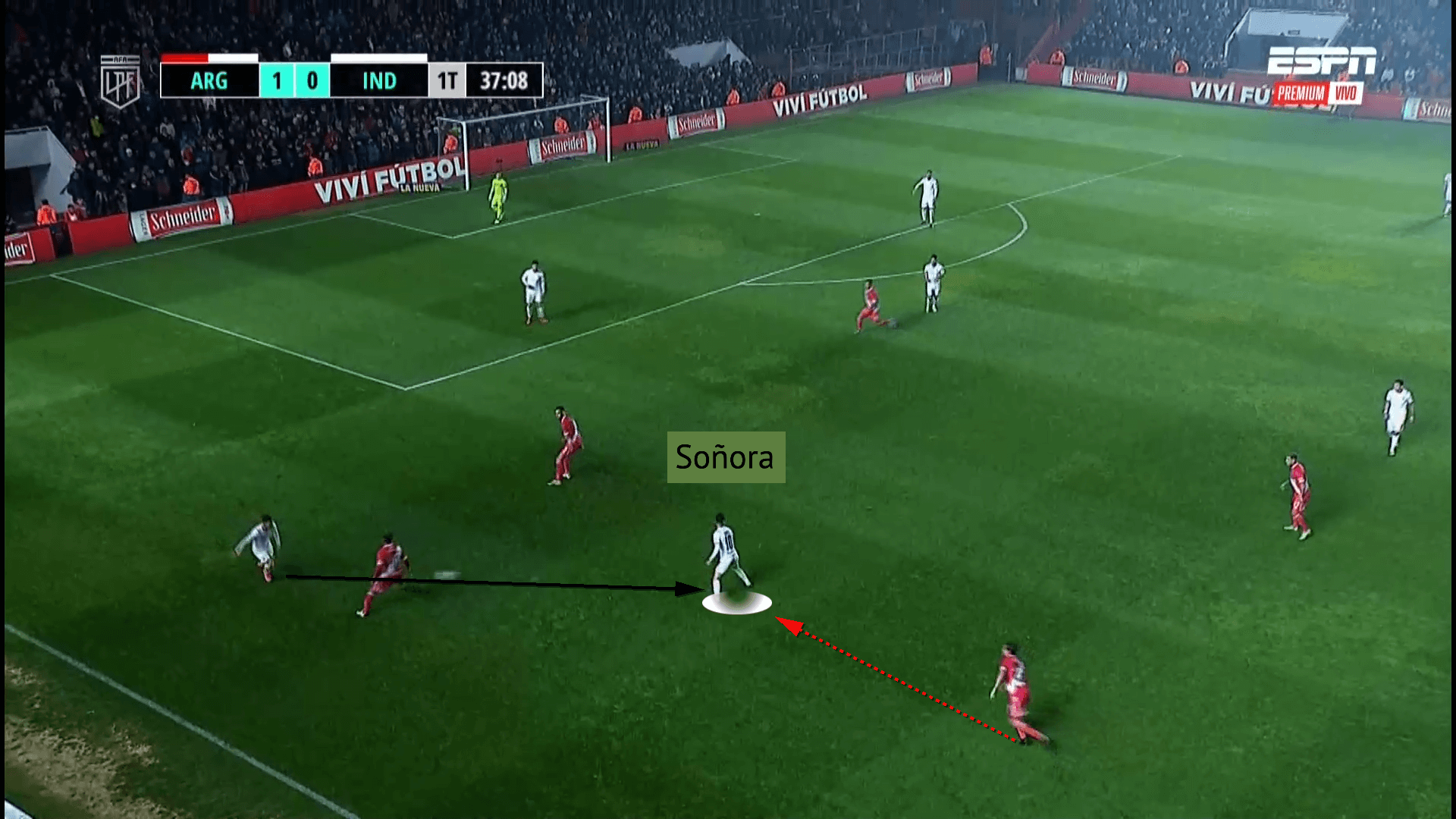
The defensive aspects of Soñora’s game are his most noticeable weak points. Although his more advanced positioning naturally impacts his defensive statistics, it is an area that will need to be developed to further the usefulness of his versatility. Competing in 4.88 defensive duels per 90, he wins 57.3% of his duels, ranking him 18th and 14th at Independiente respectively. Soñora contests in 1.64 aerial duels, ranking 17th, but his success rate of 20% ranks 23rd at the club. If deployed as an attacking midfielder, success in aerial duels is advantageous for sustaining possession and building attacks from long balls and second balls off the striker.
His 0.03 slide tackles per 90, 0.05 shots blocked, and 4.64 PAdj interceptions are also near the lowest at the club. Soñora is a slight figure, not physically imposing, but his technical qualities help him in possession. His ability to protect the ball with his body wins fouls for Independiente, but his size can impact the referee’s decisions to let the play continue instead. Soñora is not the fastest over long distances, but his balance and agility are very good for his ball manipulation.
USMNT call-up?
In the last 12 months, head coach Gregg Berhalter has called up 90 different players to USMNT camps. With such a diverse quantity of players regarding experience and current ability being called up, it can be considered strange that Alan Soñora is still yet to be selected. With the United States’ first 2022 World Cup game against Wales kicking off on the 21st of November, Soñora has limited time to make such a large impact on Berhalter’s mind before the World Cup squad selection. However, until the squad is chosen, Soñora and many others have a chance of being called up with his Independiente performances warranting international recognition.
Admittedly it is a challenge to break into the USMNT as a central midfielder, even with Soñora’s versatility. RB Leipzig’s Tyler Adams looks set to take the defensive midfield role for the next decade, with Kellyn Acosta a suitable backup option as the most capped midfielder in the last squad. Weston McKennie of Juventus and Valencia’s Yunus Musah will continue to be stalwarts in the squad despite their younger ages.
With Berhalter deploying a 4-3-3 during 80% of the United States fixtures in the last year, there could potentially be an opening in the squad for an option to appear on the left of the midfield three. With McKennie, Musah, Acosta, and Adams all expected to remain in the squad, alongside the more attacking options of Leeds United’s new signing Brenden Aaronson and Borussia Dortmund’s Giovanni Reyna, we will be looking at Soñora’s USMNT suitability against Luca de la Torre and Cristian Roldan.
Luca de la Torre, of recently relegated Dutch side Heracles Almelo, and Seattle Sounders’ Cristian Roldan were both midfield call-ups for the USMNT’s June fixtures. These players are not directly comparable, but they would essentially be competing for a place in the midfield unit at the World Cup if Berhalter was to consider Soñora. Looking at the heat maps below we can start to see the role that the three players have at club level and their potential role with the USMNT.
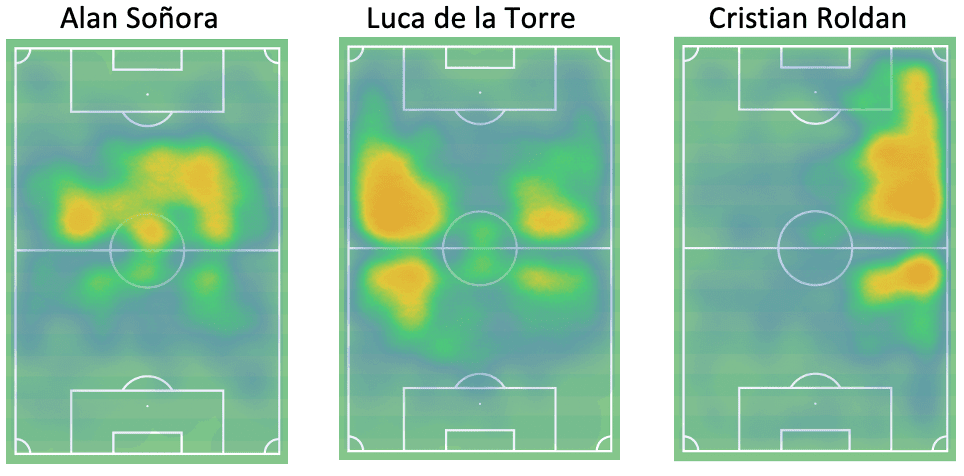
Luca de la Torre’s heat map from the 2021/22 season with Heracles shows his familiarity with occupying the spaces as a left central midfielder. The majority of de la Torre’s minutes last season were in a double pivot of a 4-4-2 or 4-2-3-1, with the American occasionally deployed as an attacking midfielder.
Roldan’s heat map is very different. He almost exclusively operates on the right side of Seattle’s 4-2-3-1, and irregularly plays as the attacking midfielder or in the double pivot, in an attacking role. His heat map has some similarities to Musah’s, and his best role in the USMNT set-up would either be in Musah’s right central midfield role or on the right-wing. However, Weston McKennie also excels in the right central midfield spaces when given freedom, alongside operating as the left central midfielder in Berhalter’s system. With McKennie capable of playing anywhere across the midfield and with Musah’s preference for the right side, there is an opportunity for Soñora to be involved in the rotation for the left central midfield role.
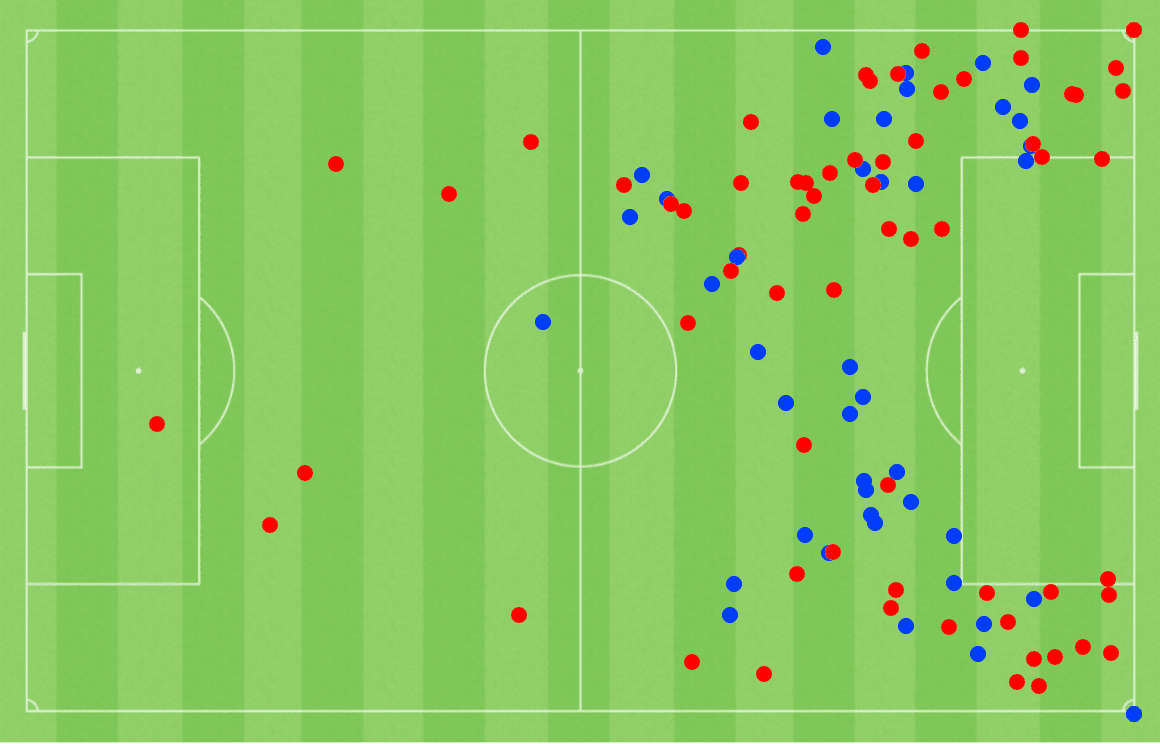
The figure above displays the pass locations of the USMNT’s penalty box entries from their last five fixtures. Blue dots indicate a completed entry, meanwhile, red dots display an incomplete entry. We can see that most of the attempted penalty box entries occur from the wide areas. During the USMNT World Cup qualifiers, left-back Antonee Robinson completed the most penalty box entries per 90, with full-backs Shaq Moore, Reggie Cannon, DeAndre Yedlin, Sergiño Dest, and George Bello all ranking in the top ten for Berhalter’s side. With the full-backs looking to advance into the final third, the USMNT need a midfielder capable of accessing the full-backs. This suits Alan Soñora excellently.
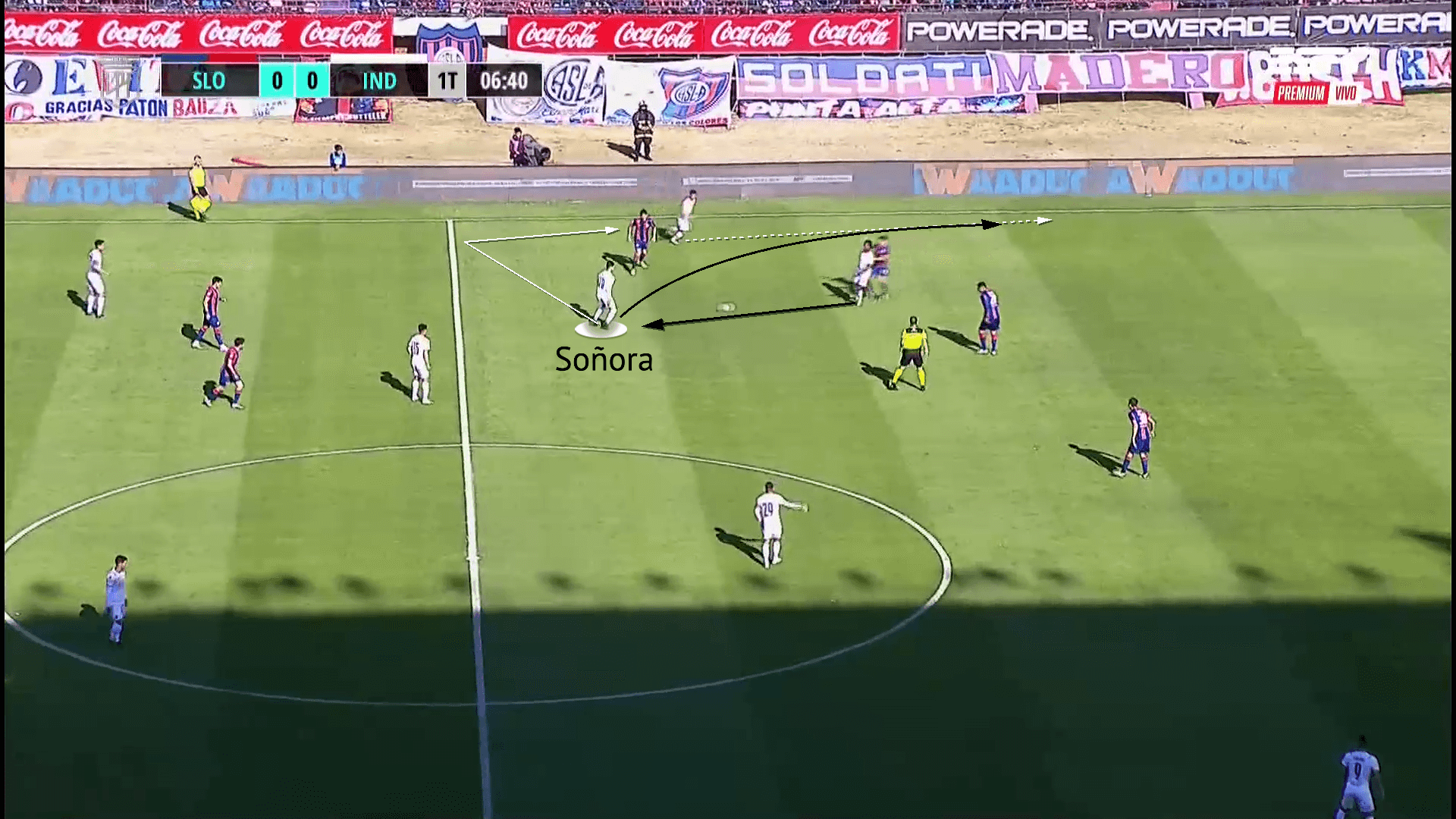
With Independiente also using the wide areas a lot, Soñora is familiar with a side looking to move wide. In the example above, Soñora has received the ball in Independiente’s up-back-through combination and executed a first-time through pass for the left-back to break forwards into the final third. Immediately after playing the pass, the American moved into a position behind the ball as a passing option to retain possession. As the left-back could not successfully penetrate the defence, Soñora received the ball back and recycled the play out towards the other wing.
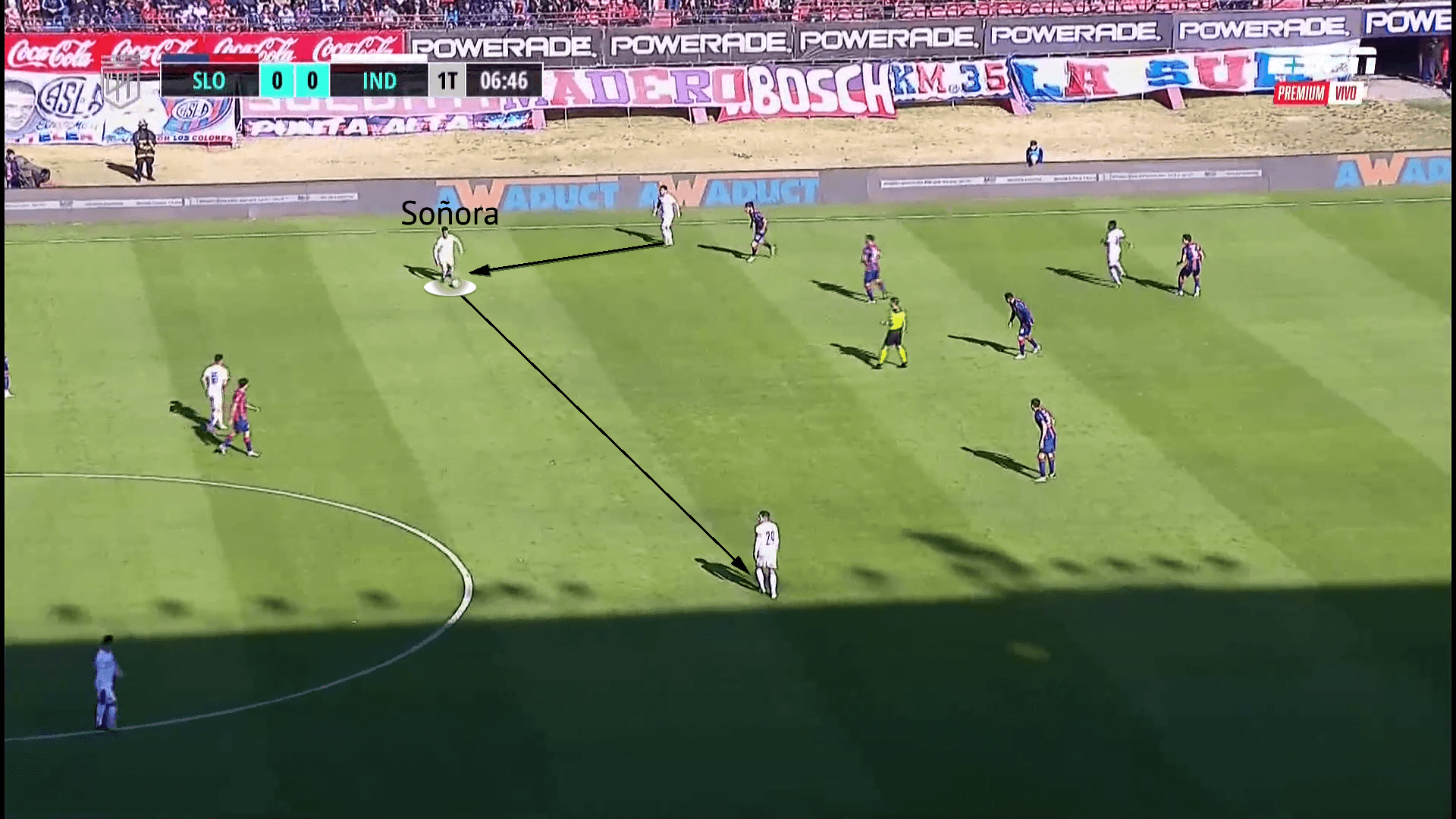
With the United States full-backs taking up higher positions, Soñora would occupy deeper spaces more frequently than at Independiente. However, these are areas where he looks really strong. Not only would this deeper positioning allow the left-back to advance, but it would also allow the right central midfielder to attack the box. The tendency to enter the opposition box is common in both McKennie and Musah, two primary options for the right central midfield role.
With Soñora in a role that facilitates the right central midfielder to advance, his responsibilities in the final third will decrease from Independiente. As mentioned earlier in the scout report, he rarely enters the opposition penalty box, so this deeper role suits his habits in possession. The table below compares some attacking third statistics with de la Torre and Roldan, but the different clubs and leagues of the players must be considered.
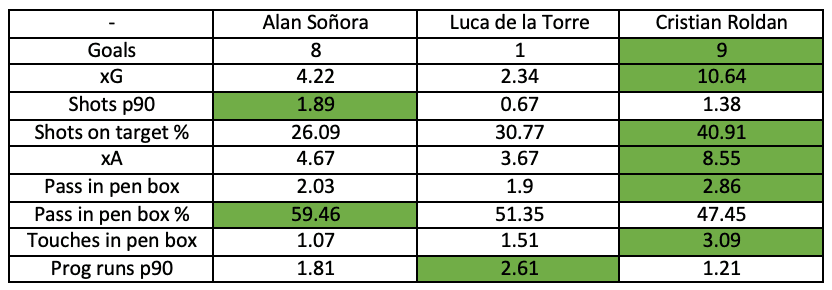
Where Soñora really does stand out in comparison to de la Torre and Roldan is the progression he offers in possession. This is another reason why a deeper role could really complement his strengths. From the table below, we can see the assertiveness and accuracy of Soñora’s progression in possession.
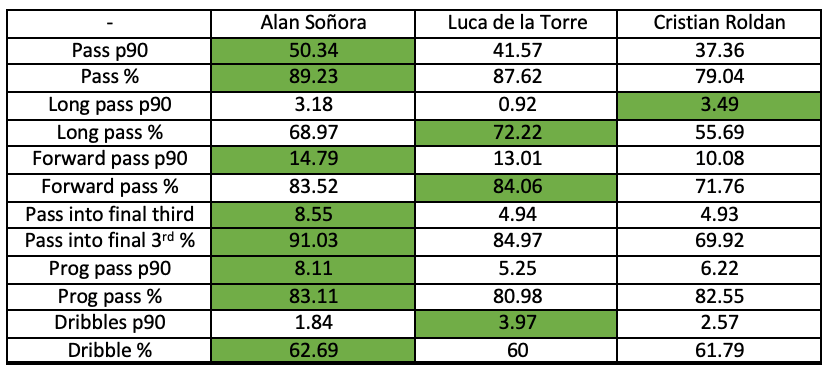
As stated earlier, Soñora is great at finding wide players, especially inverted wingers that, in turn, create space for full-backs. This is pertinent for his USMNT hopes, with winger Timothy Weah and full-backs Robinson, Yedlin, and Dest completing the most key passes in World Cup qualifying for Berhalter’s team, showing the wide players’ influence on the American attack.
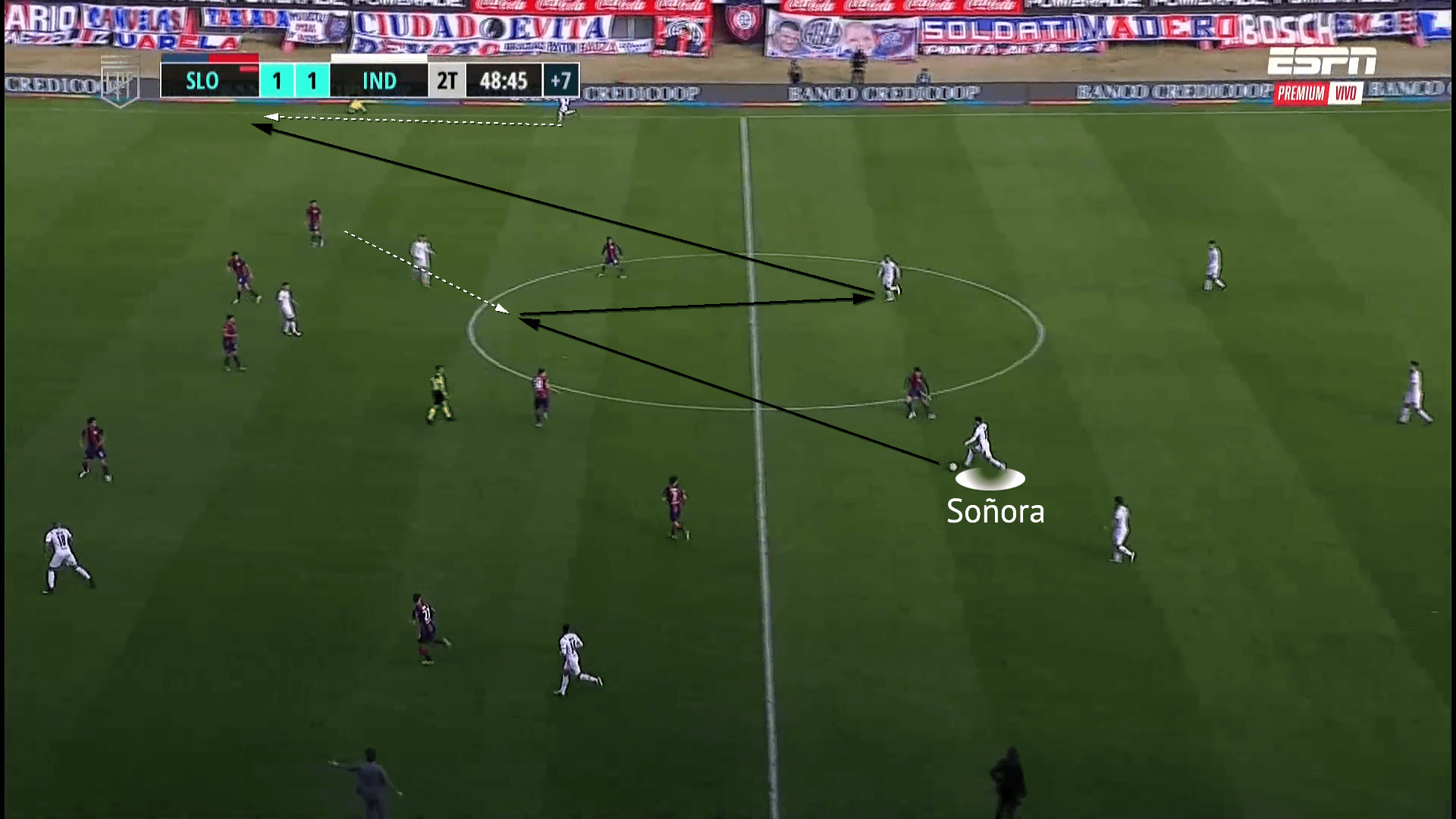
The figure above shows one of these scenarios at Independiente, with Soñora displaying his ability to accurately thread passes between the lines for the inverting winger. Soñora’s forward-thinking has sprung another up-back-through combination, with his weight of pass allowing the combination to occur with control.
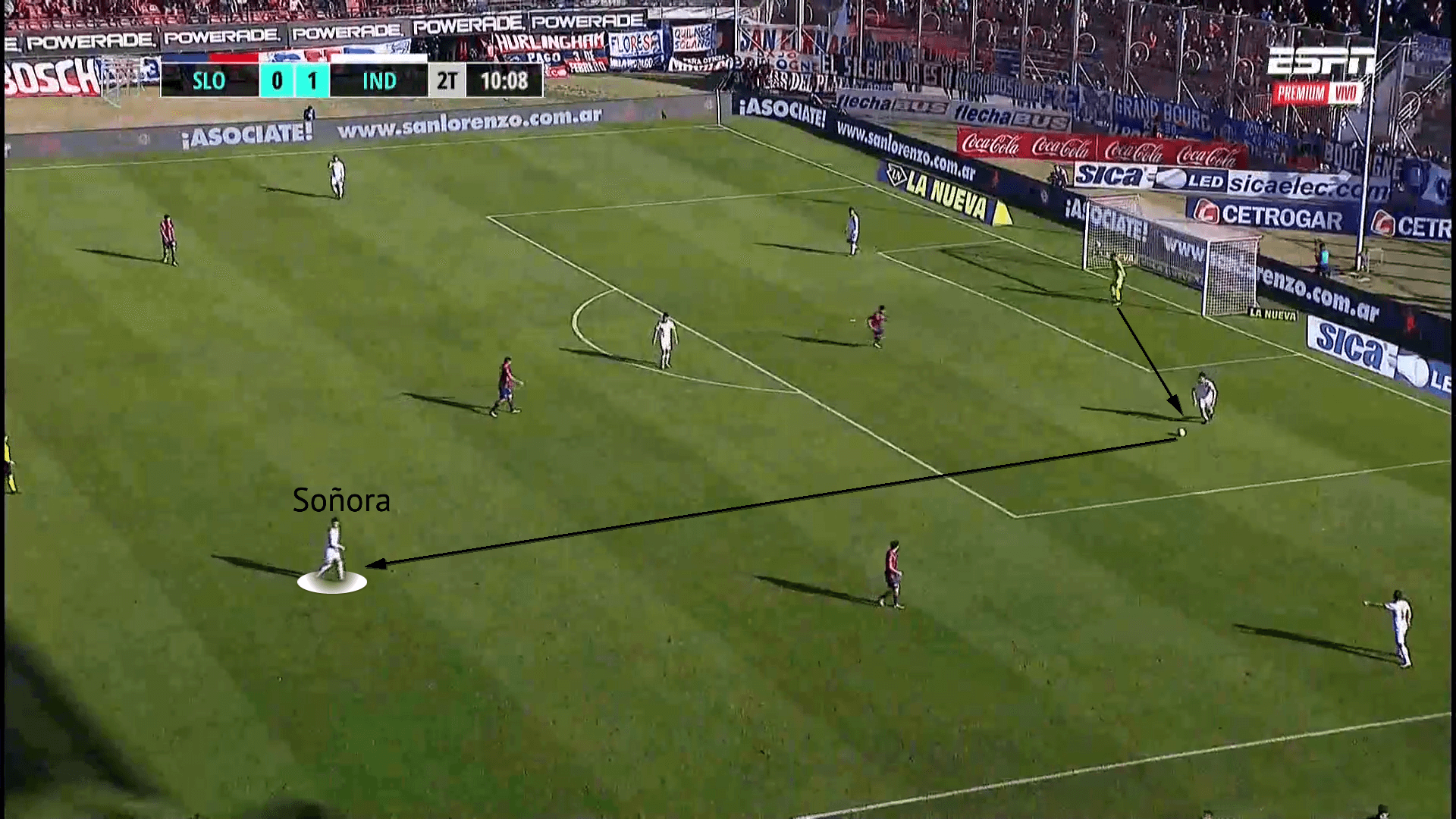
The American can also execute longer passes in behind the opposition defensive line for the attackers to run onto. With the movement off the wing and finishing ability from the likes of Paul Arriola, Jordan Morris, Timothy Weah and Christian Pulisic, the pass in behind could be particularly effective for the USMNT.
The images above and below show an example of this type of pass against San Lorenzo. Soñora has dropped away from his marker into a free to receive from the short goal kick in the build-up phase. As mentioned earlier, left-footed Soñora is scanning over his right shoulder with his back to goal, rather than scanning the larger part of the pitch in this case. After receiving between the San Lorenzo midfield and attacking lines, he is able to turn and carry possession into the opposition half. Spotting the right-wingers positioning on the shoulder of the defender, Soñora plays a lofted pass into the space behind the defence to penetrate. These passes are a different option for Berhalter’s team, with Soñora’s average pass length being longer than Acosta, Adams, McKennie and Musah’s.
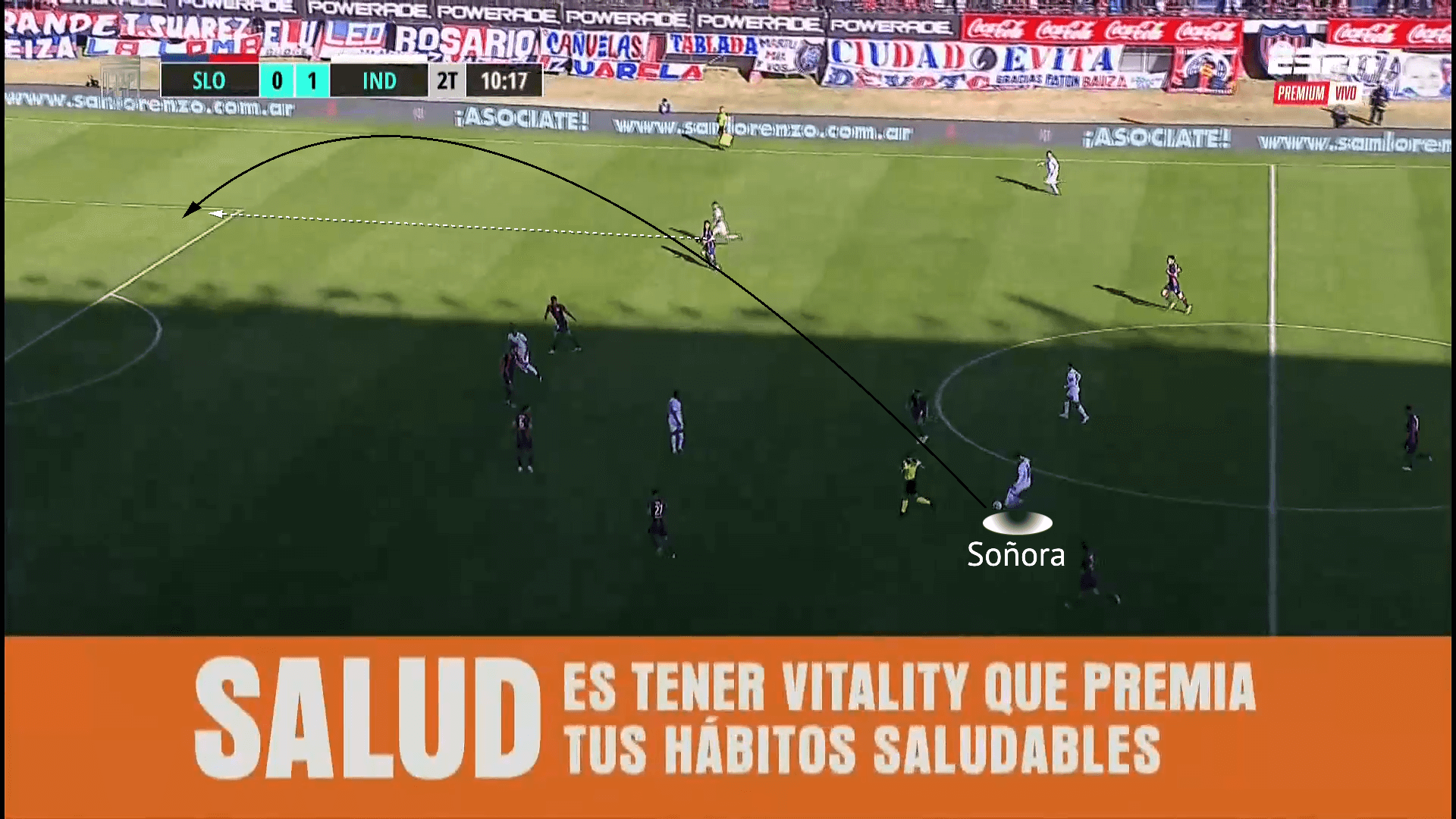
However, Soñora’s out-of-possession work is not quite up to the standard required for the World Cup. Despite his 4.64 PAdj interceptions being greater than Acosta’s and Musah’s, his overall defensive contribution needs to improve. Out of the 40 US-eligible central midfielders with a Transfermarkt value of ≥ £1,000,000, Soñora ranks 37th for defensive duels per 90.
As we can see from the table below, there is a notable difference in Soñora’s defensive contribution in comparison to Luca de la Torre and Cristian Roldan. This will be Soñora’s biggest stumbling block for a USMNT call-up. Berhalter’s preference for a hard-working, well-structured midfield doesn’t quite suit the freedom that allows Soñora’s technical qualities and nimbleness to flourish.

Conclusion
Whilst his performances at club level continue to get better, Alan Soñora has entered the last six months of his contract at Argentine giants Independiente. Now free to speak to other sides, El Rojo fans are begging the American to remain at the club. With his USA eligibility, Soñora will surely have interest from the MLS alongside clubs elsewhere in South America and potentially Europe, due to the development shown in his game.
After reiterating his desire to represent the United States, Soñora revealed that he had discussions with Berhalter regarding call-ups to the December and January camps. Club commitments prevented the possibility of a call-up at the time, but the Independiente midfielder seems to have entered Berhalter’s mind recently.
Although he is without a call-up, Soñora will be boosted by the recent appointment of the USMNT’s designated set-piece coach Lars Knudsen. Soñora is heavily involved in Independiente’s set-piece taking, being a goal-scorer from free-kicks and able to whip corners and wide free-kicks into the box whilst also being an option for short corner combinations.
Soñora’s influence in possession goes well beyond set-pieces though. His constant movement to become a passing option and ability to thread well-weighted passes into teammates make him a ball retention freak. His movement can attract opposition, but his ball manipulation and agility offer effectual press resistance to retain and progress possession. His habits when operating in deeper areas would accentuate the influence of the USMNT’s full-backs and allow the right central midfielder to enter the box more frequently.
With the climatic conditions of the 2022 World Cup in Qatar, sustaining possession with Soñora could be crucial for Berhalter’s hopes of progressing into the latter stages. However, the out-of-possession work from Soñora will be the highlighted limitation by Berhalter. This can still be improved, but the different profile that Soñora provides could be worth a shock selection in the coming months.
In this analysis, we have looked at Alan Soñora’s role under Eduardo Domínguez in Independiente’s tactics. We have also identified the possibility of Soñora receiving a call-up for the USMNT, comparing him to other American midfield selection hopefuls and discussed how Soñora could effectively fit into the national team.

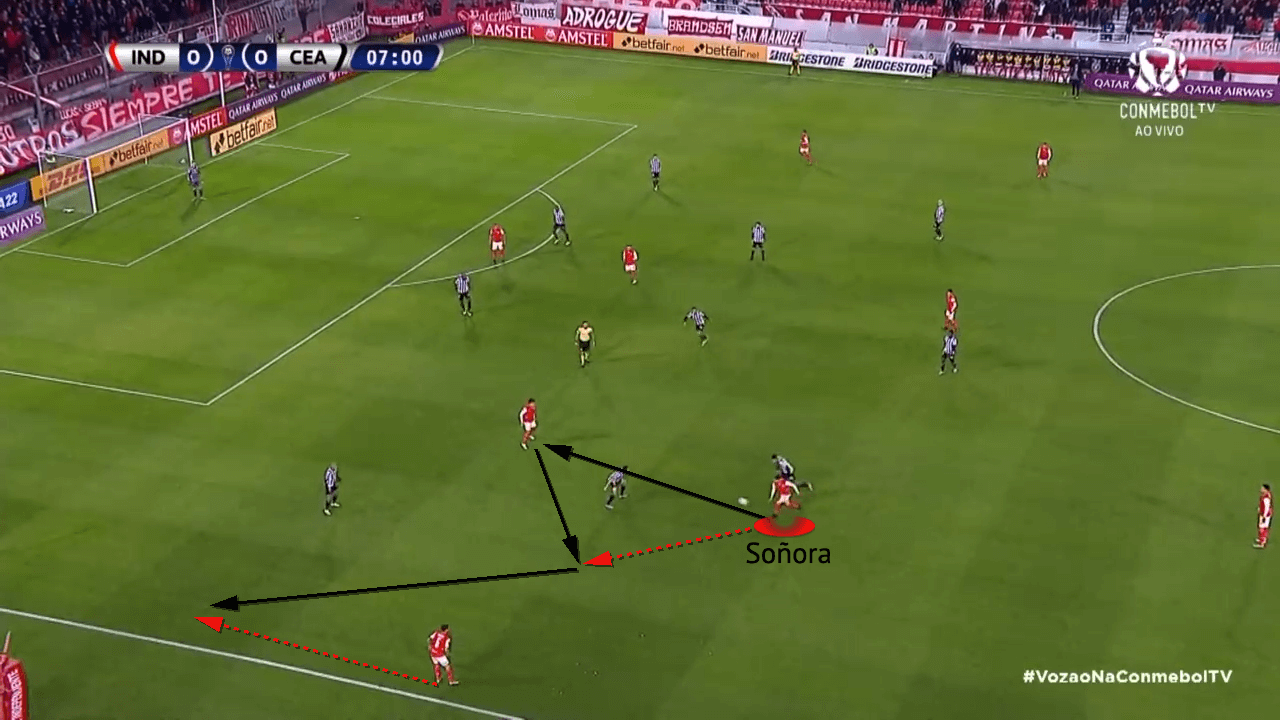




Comments